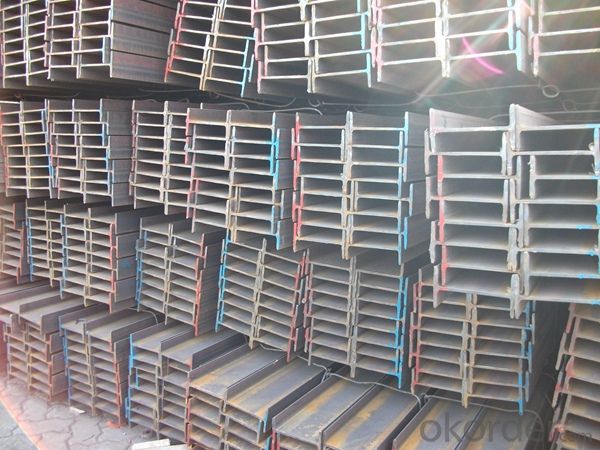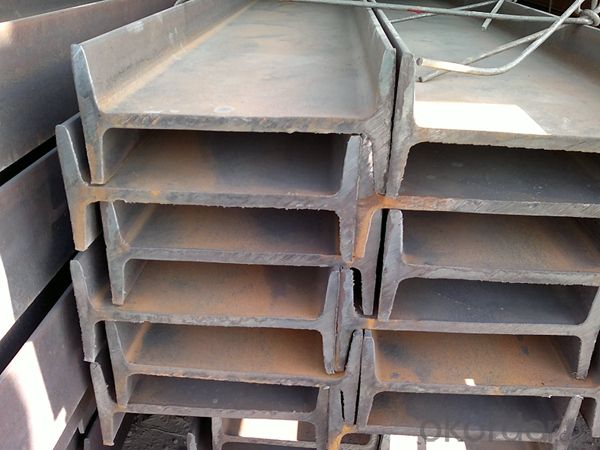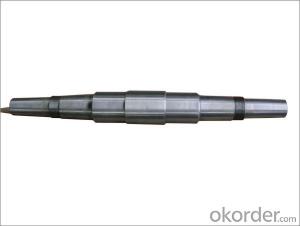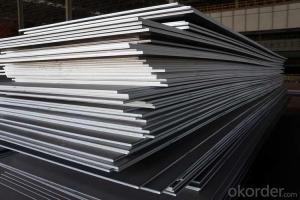High Quality Hot Rolled Steel I Beams for Constrcution
- Loading Port:
- Tianjin
- Payment Terms:
- TT OR LC
- Min Order Qty:
- 25 m.t.
- Supply Capability:
- 200000 m.t./month
OKorder Service Pledge
OKorder Financial Service
You Might Also Like
Product Description:
OKorder is offering high quality Hot Rolled Steel I-Beams at great prices with worldwide shipping. Our supplier is a world-class manufacturer of steel, with our products utilized the world over. OKorder annually supplies products to European, North American and Asian markets. We provide quotations within 24 hours of receiving an inquiry and guarantee competitive prices.
Product Applications:
Hot Rolled Steel I-Beams are ideal for structural applications and are widely used in the construction of buildings and bridges, and the manufacturing, petrochemical, and transportation industries.
Product Advantages:
OKorder's Steel I-Beams are durable, strong, and resist corrosion.
Main Product Features:
· Premium quality
· Prompt delivery & seaworthy packing (30 days after receiving deposit)
· Corrosion resistance
· Can be recycled and reused
· Mill test certification
· Professional Service
· Competitive pricing
Product Specifications:
Manufacture: Hot rolled
Grade: Q195 – 235
Certificates: ISO, SGS, BV, CIQ
Length: 6m – 12m, as per customer request
Packaging: Export packing, nude packing, bundled
Chinese Standard (H*W*T) | Weight (Kg/m) | 6m (pcs/ton) | Light I (H*W*T) | Weight (Kg/m) | 6m (pcs/ton) | Light II (H*W*T) | Weight (Kg/m) | 6M |
100*68*4.5 | 11.261 | 14.8 | 100*66*4.3 | 10.13 | 16.4 | 100*64*4 | 8.45 | 19.7 |
120*74*5.0 | 13.987 | 11.9 | 120*72*4.8 | 12.59 | 13.2 | 120*70*4.5 | 10.49 | 15.8 |
140*80*5.5 | 16.89 | 9.8 | 140*78*5.3 | 15.2 | 10.9 | 140*76*5 | 12.67 | 13.1 |
160*88*6 | 20.513 | 8.1 | 160*86*5.8 | 18.46 | 9 | 160*84*5.5 | 15.38 | 10.8 |
180*94*6.5 | 24.143 | 6.9 | 180*92*6.3 | 21.73 | 7.6 | 180*90*6 | 18.11 | 9.2 |
200*100*7 | 27.929 | 5.9 | 200*98*6.8 | 25.14 | 6.6 | 200*96*6.5 | 20.95 | 7.9 |
220*110*7.5 | 33.07 | 5 | 220*108*7.3 | 29.76 | 5.6 | 220*106*7 | 24.8 | 6.7 |
250*116*8 | 38.105 | 4.3 | 250*114*7.8 | 34.29 | 4.8 | 250*112*7.5 | 28.58 | 5.8 |
280*122*8.5 | 43.492 | 3.8 | 280*120*8.2 | 39.14 | 4.2 | 280*120*8 | 36.97 | 4.5 |
300*126*9 | 48.084 | 3.4 | 300*124*9.2 | 43.28 | 3.8 | 300*124*8.5 | 40.87 | 4 |
320*130*9.5 | 52.717 | 3.1 | 320*127*9.2 | 48.5 | 3.4 | |||
360*136*10 | 60.037 | 2.7 | 360*132*9.5 | 55.23 | 3 |
FAQ:
Q1: Why buy Materials & Equipment from OKorder.com?
A1: All products offered byOKorder.com are carefully selected from China's most reliable manufacturing enterprises. Through its ISO certifications, OKorder.com adheres to the highest standards and a commitment to supply chain safety and customer satisfaction.
Q2: How do we guarantee the quality of our products?
A2: We have established an advanced quality management system which conducts strict quality tests at every step, from raw materials to the final product. At the same time, we provide extensive follow-up service assurances as required.
Q3: How soon can we receive the product after purchase?
A3: Within three days of placing an order, we will begin production. The specific shipping date is dependent upon international and government factors, but is typically 7 to 10 workdays.
Q4: What makes stainless steel stainless?
A4: Stainless steel must contain at least 10.5 % chromium. It is this element that reacts with the oxygen in the air to form a complex chrome-oxide surface layer that is invisible but strong enough to prevent further oxygen from "staining" (rusting) the surface. Higher levels of chromium and the addition of other alloying elements such as nickel and molybdenum enhance this surface layer and improve the corrosion resistance of the stainless material.
Q5: Can stainless steel rust?
A5: Stainless does not "rust" as you think of regular steel rusting with a red oxide on the surface that flakes off. If you see red rust it is probably due to some iron particles that have contaminated the surface of the stainless steel and it is these iron particles that are rusting. Look at the source of the rusting and see if you can remove it from the surface.
Images:
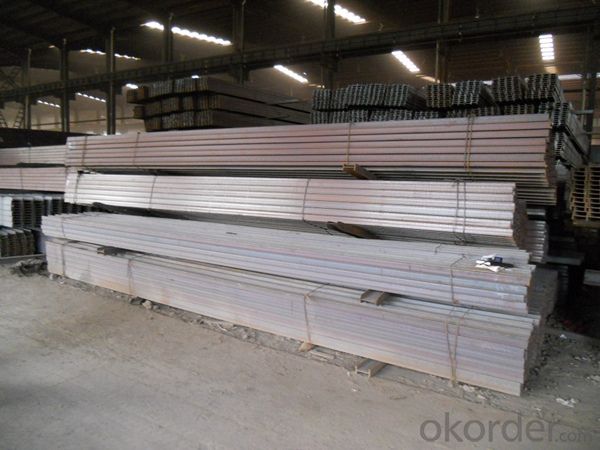

- Q: Can steel I-beams be used in hospitals or healthcare facilities?
- Yes, steel I-beams can be used in hospitals or healthcare facilities. Steel I-beams are commonly used in the construction industry due to their strength, durability, and load-bearing capacity. In healthcare facilities, where the safety and integrity of the structure are crucial, steel I-beams can provide the necessary support for the building. They are often used in the construction of floors, walls, and roofs, ensuring the stability of the overall structure. Additionally, steel I-beams are resistant to fire, pests, and weathering, making them a reliable choice for healthcare facilities that require a long-lasting and low-maintenance construction solution.
- Q: What is the free length of the compression flange?
- Here is an example of a lateral support in the span of the beam, so the free length of the compression flange is 6 meters.
- Q: How is a steel I-beam manufactured?
- The process of manufacturing a steel I-beam involves a technique known as hot rolling, which includes heating and shaping a steel billet. The manufacturing procedure for a steel I-beam can be summarized as follows: 1. Raw materials: Commencing with the selection of high-quality raw materials, typically steel billets produced from recycled scrap metal. 2. Heating: The steel billet is subjected to heat in a furnace until it reaches a molten state, making it malleable and easy to shape. 3. Rolling: Once the steel billet has been heated, it undergoes a series of passes through rolling mills. These mills apply pressure to mold the steel into the desired I-beam profile. The rolling process consists of multiple passes, gradually reducing the thickness and increasing the length of the steel. 4. Cooling: After the rolling process, the steel I-beam is cooled to room temperature to stabilize its structure and prevent warping or deformations. 5. Cutting: The cooled steel I-beam is then cut into specific lengths according to the required dimensions using saws or flame cutting methods. 6. Surface treatment: Depending on the intended application, the steel I-beam may receive various surface treatments to enhance durability and aesthetics. These treatments may include galvanizing, painting, or the application of a protective coating. 7. Quality control: Throughout the manufacturing process, strict quality control measures are implemented to ensure that the I-beams meet the required standards and specifications. This includes inspecting the dimensions, mechanical properties, and visual appearance of each steel I-beam. 8. Packaging and shipping: Once the I-beams have passed the quality control tests, they are packaged and prepared for shipment to construction sites or steel suppliers. In conclusion, the manufacturing of a steel I-beam involves a combination of high-temperature processing, rolling, cutting, and quality control measures to create a robust and structurally sound product. This process allows for the production of I-beams in various sizes and lengths to meet the specific requirements of construction projects.
- Q: Can steel I-beams be used in railway or transportation infrastructure?
- Yes, steel I-beams can be used in railway or transportation infrastructure. They are commonly used for constructing bridges, overpasses, and railway tracks due to their strength, durability, and load-bearing capacity. Steel I-beams provide structural support, ensuring the integrity and safety of the transportation infrastructure.
- Q: How do steel I-beams perform in terms of fire safety?
- Steel I-beams perform well in terms of fire safety due to their inherent fire-resistant properties. Steel has a high melting point, which makes it less susceptible to structural failure during a fire. Additionally, steel I-beams do not contribute to the spread of fire as they do not burn or release toxic gases. However, prolonged exposure to high temperatures can weaken steel, so proper fire protection measures such as fire-resistant coatings or insulation are necessary to maintain their structural integrity in a fire.
- Q: What are the potential cost savings associated with using steel I-beams?
- Using steel I-beams in construction projects offers various potential cost savings. Firstly, steel I-beams possess a high strength-to-weight ratio, enabling them to support heavy loads while utilizing less material compared to other options. This results in cost savings through reduced material expenses and transportation costs. Moreover, steel I-beams exhibit durability and resistance to decay, pests, and fire. Consequently, they have a longer lifespan compared to alternative materials, leading to lower maintenance and replacement costs over time. Additionally, steel I-beams are relatively quick and simple to install, particularly when contrasted with traditional construction methods. This can lead to significant time savings, ultimately translating into reduced labor expenses. Furthermore, steel is a highly recyclable material. In the event of remodeling or demolishing a structure that employs steel I-beams, the beams can be efficiently recycled and reused. This not only reduces waste but also potentially diminishes the overall environmental impact of the project. Lastly, steel I-beams are readily available in standard sizes, streamlining the construction process and minimizing the necessity for customized fabrication. This standardization can yield cost savings by reducing lead times and enhancing production efficiency. In summary, the potential cost savings associated with utilizing steel I-beams encompass reduced material and transportation expenses, decreased maintenance and replacement outlays, expedited installation times, recyclability, and enhanced production efficiency.
- Q: How do you mark the types of steel such as channel, I-beam and so on in the document?
- According to the section shape, the section steel is divided into simple section steel and complex section steel (deformed steel). The former refers to the steel, round steel, flat steel, angle steel, six angle steel; the latter refers to the I-beam, channel steel, steel, steel, steel frame bending etc.
- Q: Can steel I-beams be used for food processing plants?
- Yes, steel I-beams can be used for food processing plants. Steel I-beams are commonly used in construction for their strength, durability, and load-bearing capabilities. These properties make them suitable for supporting heavy equipment, machinery, and structures in food processing plants. Additionally, steel I-beams are resistant to corrosion, which is important in environments where food safety and hygiene are paramount. They can also be easily cleaned and maintained, ensuring a safe and sanitary processing environment. Overall, steel I-beams are a popular choice in the construction of food processing plants due to their strength, durability, and suitability for the specific requirements of the industry.
- Q: Can steel I-beams be used in sports arenas or stadiums?
- Yes, steel I-beams can be used in sports arenas or stadiums. They are commonly used in the construction of large-scale structures due to their strength, durability, and ability to support heavy loads.
- Q: Can steel I-beams be used in overhead crane systems?
- Yes, steel I-beams can be used in overhead crane systems. They are commonly used as the main support structure for the crane and provide the necessary strength and durability to lift and transport heavy loads safely.
Send your message to us
High Quality Hot Rolled Steel I Beams for Constrcution
- Loading Port:
- Tianjin
- Payment Terms:
- TT OR LC
- Min Order Qty:
- 25 m.t.
- Supply Capability:
- 200000 m.t./month
OKorder Service Pledge
OKorder Financial Service
Similar products
Hot products
Hot Searches
Related keywords



